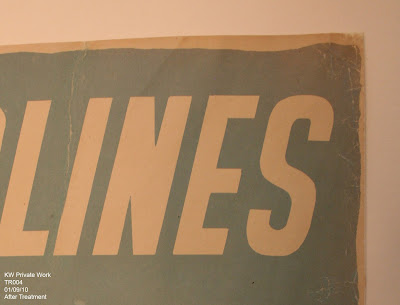The following book (GII b9) received in-situ repair rather than full conservation treatment. The volume was made up of pamphlets of different dimensions sewn together in one volume. On receipt eight of the pamphlets were loose and in danger of being separated from the rest of the volume. First the loose sections were resewn in place around the original sewing supports. Next, to provide additional stability to the structure a new Japanese spine lining was pasted to the spine without removal of the cover leather.
The following images give further information as to how this repair was carried out. This method was developed by Alessandro Scola here at Derry & Raphoe, I found the method very innovative and effective.
 View of loose pamphlets before conservation
View of loose pamphlets before conservation Sliding reemay strips between cover leather and spine
Sliding reemay strips between cover leather and spine
First two strips of reemay were slipped between the leather and the spine. In the case of this book the leather came away from the spine creating a natural hollow, making this process relatively easy.
 Book held tight with boards supported
Book held tight with boards supported
Next the book was placed in a finishing press to compress the textblock in preparation for the lining. A camera stand was used to hold the boards and provide support to the joints during this process.

Japanese spine lining between reemay, being pulled onto spine
Next I pasted strips of spine lining paper and put them between the reemay strips (reemay, pasted paper, reemay). The strips should be longer on the side with the paper, but enough reemay needs to be on the other side to pull them through. Once in place I pulled the reemay, paper and reemay sandwich from one side to the other leaving a little extra Japanese paper on either side of the textblock. The piece of reemay closest to the textblock was then pulled out and the second piece left in place. After all the panels were lined, leaving the reemay in place I wrapped the book with a bandage to give some pressure on the new spine lining.
 Removal of reemay after lining has dried under pressure from a bandage
Removal of reemay after lining has dried under pressure from a bandage
 Book completed with new lining
Book completed with new lining
 Removal of reemay after lining has dried under pressure from a bandage
Removal of reemay after lining has dried under pressure from a bandage
Finally, after enough drying time I removed the bandage and reemay. In the case of my book I cut the excess paper flush with the textblock, however if you needed more support for the joint you could use the paper as a flange for added joint support.
 Book completed with new lining
Book completed with new lining  Front cover before conservation
Front cover before conservation Front cover after conservation
Front cover after conservation  View of back cover before conservation
View of back cover before conservation  View of back cover after conservation
View of back cover after conservation  View of spine before conservation
View of spine before conservation View of spine after conservation with new toned cloth reback
View of spine after conservation with new toned cloth reback  Inside front cover before conservation
Inside front cover before conservation  View of inside cover after conservation with Japanese hinge
View of inside cover after conservation with Japanese hinge 













